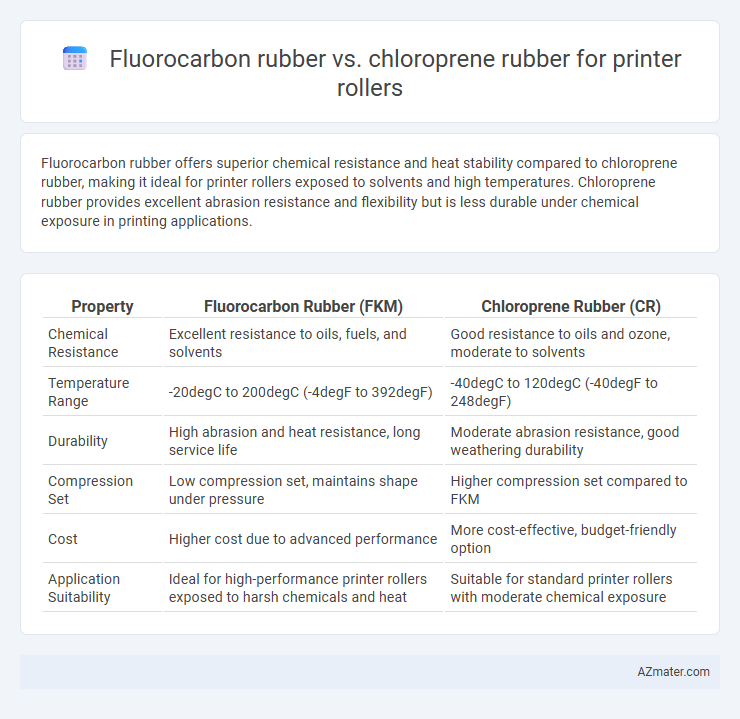Fluorocarbon rubber offers superior chemical resistance and heat stability compared to chloroprene rubber, making it ideal for printer rollers exposed to solvents and high temperatures. Chloroprene rubber provides excellent abrasion resistance and flexibility but is less durable under chemical exposure in printing applications.
Table of Comparison
| Property | Fluorocarbon Rubber (FKM) | Chloroprene Rubber (CR) |
|---|---|---|
| Chemical Resistance | Excellent resistance to oils, fuels, and solvents | Good resistance to oils and ozone, moderate to solvents |
| Temperature Range | -20degC to 200degC (-4degF to 392degF) | -40degC to 120degC (-40degF to 248degF) |
| Durability | High abrasion and heat resistance, long service life | Moderate abrasion resistance, good weathering durability |
| Compression Set | Low compression set, maintains shape under pressure | Higher compression set compared to FKM |
| Cost | Higher cost due to advanced performance | More cost-effective, budget-friendly option |
| Application Suitability | Ideal for high-performance printer rollers exposed to harsh chemicals and heat | Suitable for standard printer rollers with moderate chemical exposure |
Introduction to Printer Roller Materials
Fluorocarbon rubber and chloroprene rubber are commonly used materials for printer rollers, each offering distinct chemical and physical properties. Fluorocarbon rubber provides exceptional resistance to heat, chemicals, and oils, making it ideal for high-performance printing environments requiring durability and long service life. Chloroprene rubber offers good abrasion resistance and moderate chemical stability, suitable for general-purpose printers where cost-effectiveness and flexibility are prioritized.
Overview of Fluorocarbon Rubber
Fluorocarbon rubber, known for its exceptional chemical resistance and high-temperature stability, outperforms chloroprene rubber in demanding printer roller applications that require durability against solvents and inks. Its resistance to abrasion and compression set ensures prolonged roller life and consistent print quality. Fluorocarbon rubber's low permeability and excellent mechanical properties make it ideal for maintaining roller performance under continuous operation.
Overview of Chloroprene Rubber
Chloroprene rubber (CR) is a synthetic elastomer widely used in printer rollers due to its excellent balance of chemical resistance, flexibility, and durability. It exhibits strong resistance to ozone, weathering, and oils, making it suitable for long-lasting performance in various printing environments. Compared to fluorocarbon rubber, chloroprene offers cost-effective abrasion resistance and mechanical strength, ideal for applications requiring moderate heat and chemical exposure.
Key Properties Comparison: Fluorocarbon vs Chloroprene Rubber
Fluorocarbon rubber offers superior chemical resistance, high-temperature stability up to 200degC, and excellent ozone and weather resistance, making it ideal for printer rollers exposed to harsh solvents and heat. Chloroprene rubber provides good abrasion resistance, moderate chemical and heat resistance up to 120degC, and better elasticity for smooth ink transfer in standard printing environments. Choosing between fluorocarbon and chloroprene rubber depends on the printer roller's operational demands, with fluorocarbon preferred for durability under aggressive conditions and chloroprene suited for cost-effective, general-purpose use.
Chemical Resistance in Printer Roller Applications
Fluorocarbon rubber exhibits superior chemical resistance to inks, solvents, and cleaning agents commonly used in printer roller applications, ensuring longer service life and minimal degradation. Chloroprene rubber offers adequate chemical resistance but tends to swell or degrade faster when exposed to aggressive printing chemicals. Selecting fluorocarbon rubber enhances durability and maintains roller performance under harsh chemical exposure, making it the preferred choice for high-demand printing environments.
Thermal Stability and Temperature Performance
Fluorocarbon rubber exhibits superior thermal stability and can withstand continuous temperatures up to 230degC, making it ideal for printer rollers operating in high-heat environments. Chloroprene rubber, with a maximum temperature resistance around 120degC, offers moderate thermal performance but degrades faster under prolonged heat exposure. The enhanced temperature resistance of fluorocarbon rubber ensures better durability and consistent roller performance in demanding printing applications.
Wear, Abrasion, and Longevity
Fluorocarbon rubber exhibits superior wear and abrasion resistance compared to chloroprene rubber, making it highly suitable for printer rollers subjected to continuous mechanical stress. Its chemical stability enhances longevity, maintaining performance under exposure to inks and cleaning solvents, whereas chloroprene rubber tends to degrade faster under similar conditions. The durability of fluorocarbon rubber ensures extended service life and reduced maintenance frequency in high-speed printing applications.
Cost Implications and Availability
Fluorocarbon rubber offers superior chemical resistance and durability for printer rollers, but its higher raw material and processing costs can limit its cost-effectiveness in large-scale production. Chloroprene rubber provides a more affordable alternative with good mechanical properties and wider market availability, making it a preferred choice for budget-sensitive applications. Availability of chloroprene is more consistent globally, whereas fluorocarbon's specialty status can lead to longer lead times and supply constraints.
Application Suitability: Which Rubber Fits Your Printer Roller?
Fluorocarbon rubber offers superior chemical resistance and high-temperature durability, making it ideal for printer rollers exposed to aggressive inks and solvents in industrial printing applications. Chloroprene rubber provides excellent abrasion resistance and good elasticity, suitable for general-purpose printer rollers requiring moderate chemical exposure and consistent performance. Choosing the right rubber depends on the printer roller's operating environment, with fluorocarbon rubber fitting high-demand, chemically-intensive settings and chloroprene rubber best for standard, cost-effective use.
Conclusion: Choosing the Right Material for Print Quality
Fluorocarbon rubber offers superior chemical resistance, thermal stability, and durability, making it ideal for high-quality printer rollers in demanding environments. Chloroprene rubber provides good flexibility and cost-effectiveness but falls short in withstanding aggressive inks and solvents compared to fluorocarbon. For optimal print quality and longevity of printer rollers, fluorocarbon rubber is the preferred material despite its higher initial cost.

Infographic: Fluorocarbon rubber vs Chloroprene rubber for Printer roller
 azmater.com
azmater.com